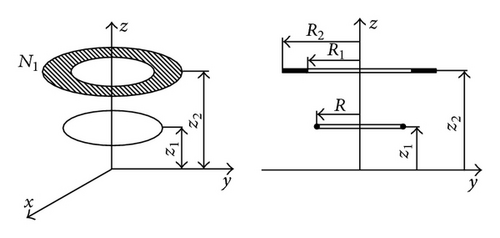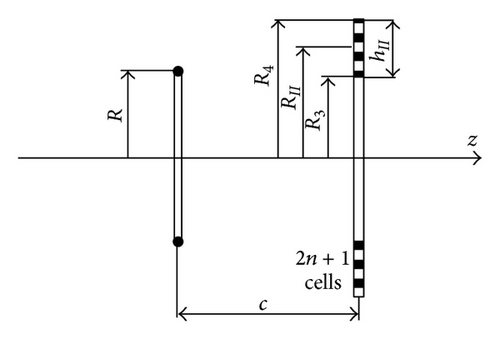Mutual Inductance and Magnetic Force Calculations for Bitter Disk Coil (Pancake) with Nonlinear Radial Current and Filamentary Circular Coil with Azimuthal Current
Abstract
Bitter coils are electromagnets used for the generation of extremely strong magnetic fields superior to 30 T. In this paper we calculate the mutual inductance and the magnetic force between Bitter disk (pancake) coil with the nonlinear radial current and the circular filamentary coil with the azimuthal current. The close form expressed over complete elliptic integrals of the first and second kind as well as Heuman’s Lambda function is obtained for this configuration either for the mutual inductance or for the magnetic force. The results of this method are compared with those obtained by the improved modified filament method for the presented configuration. All results are in an excellent agreement.
1. Introduction
In the literature and scientific papers the calculation of the mutual inductance and the magnetic force between ordinary circular coils with the uniform current densities have been given by different methods either analytical or numerical [1–15]. However, there are not a lot references about the mutual inductance and the magnetic force calculation between circular coils in which the current densities are not uniform. The coils with this characteristic are Bitter coils or Bitter solenoids. Bitter coils are used in high magnetic field applications and they differ from the ordinary coils in that they have an inverse radial distribution of current [16, 17]. The interesting point is the calculation of the mutual inductance and the magnetic force between Bitter coils or between one Bitter coil and an ordinary coil. Generally, the calculation of the magnetic force between circular coils is closely related to the calculation of their mutual inductance. Since their mutual energy is equal to the product of their mutual inductance and the currents in the coils, the component of the magnetic force of attraction or repulsion in any direction is equal to the product of the currents multiplied by the differential coefficient of the mutual inductance taken with respect to that coordinate. The mutual inductance and the magnetic force are obtained over multiple integrals with the different kernel functions. Thus, in the calculation of the mutual inductance and the corresponding magnetic force between two coils we need to integrate their kernel functions depending on coil configurations. Hopefully, these kernel functions are Green functions r−0.5 and r−1.5, where the “r” is the distance between two coils. This integral approach, much easier than the differential approach, leads to relatively simple expressions which are incorporated in these two physical quantities. In this paper we calculate the mutual inductance between the Bitter disk coil with nonlinear radial current and a circular filamentary coil with the azimuthal current (ordinary coil). Coils are coaxial and in air. Either the mutual inductance or the magnetic force is obtained in closed form expressed over complete elliptic integrals of the first and second kind as well as over Heuman’s Lambda function [18, 19]. The results of these calculations will be compared to those obtained by the improved filament method for concerned configuration. The results obtained by these two methods are in an excellent agreement.
2. Basic Expressions

μ0 = 4π × 10−7 H/m is the permeability of free space (vacuum), and r, θ, z are the cylindrical coordinates. Both coils are in air or in a nonmagnetic and nonconducting environment.
In [2] the magnetic force is obtained in the close form expressed over the complete elliptic integral of the first kind and Heuman’s Lambda function and the magnetic force in the semianalytical form expressed over complete elliptic integral of the first and second kind, Heuman’s Lambda function plus one simple integral which has to be evaluated by some of the numerical integrations [1].
3. Calculation Method
3.1. Special Cases and Singularities
Mutual Inductance. In the mutual inductance calculation special cases and singular cases appear for zQ = 0 and or zQ = 0 and .
3.1.1. zQ = 0 and
3.1.2. zQ = 0 and
This case is the singular case (R = R1 or R = R2) for which the term Tn is equal either 4R1 or 4R2.
Magnetic Force. In the magnetic force calculation for zQ = 0 its value is zero because the coils are in the same plane.
Notation Above. Λ0 corresponds to Heuman’s Lambda function as defined in [18, 19] and “sign” function returns integer indicating the sign of a number. Functions K and E correspond to complete elliptic integrals of the first and second kind [18, 19].
4. Modified Filament Method
In [17] the mutual inductance is calculated between the Bitter coil and the superconducting coil with uniform current density by using the filament method. Here we give the modified formulas for the mutual inductance and the magnetic force for the treated configuration (see Figure 2) using the filament method.

5. Examples
To verify the validity of the new formulas, we apply them to the following set of examples.
Example 1. Calculate the mutual inductance and the magnetic force between the Bitter disk coil and a filamentary circular coil with the following dimensions and the number of turns. Currents in coils are unit.
Filamentary Circular Coil. R = 20 mm, z1 = 0 mm.
Bitter Disk Coil. R1 = 40 mm, R2 = 60 mm, z2 = 50 mm, N1 = 100.
Applying (8) and (9) the mutual inductance and the magnetic force are, respectively,
By using the modified filament, (13) and (14), we obtain
Example 2. Calculate the mutual inductance between a disk and a filamentary circular coil with the following dimensions and the number of turns.
Filamentary Circular Coil. R = 20 mm, z1 = 0 mm.
Disk Coil. R1 = 40 mm, R2 = 60 mm, z2 = 0 mm, N1 = 100.
Applying (8) and (9) the mutual inductance and the magnetic force are, respectively,
By using the modified filament, (13) and (14), we obtain
Example 3. Calculate the mutual inductance between a disk and a filamentary circular coil with the following dimensions and the number of turns.
Filamentary Circular Coil. R = 40 mm, z1 = 0 mm.
Disk Coil. R1 = 40 mm, R2 = 60 mm, z2 = 0 mm, N1 = 100.
This case is the singular case because R = R1.
Applying (8), (9), and (11) the mutual inductance and the magnetic force are, respectively,
By using the modified filament, (13) and (14), we obtain
Example 4. Calculate the mutual inductance between a disk and a filamentary circular coil with the following dimensions and the number of turns.
Filamentary Circular Coil. R = 60 mm, z1 = 0 mm.
Disk Coil. R1 = 40 mm, R2 = 60 mm, z2 = 0 mm, N1 = 100.
This case is also the singular case for which R = R2.
Applying (8), (9), and (11) the mutual inductance and the magnetic force are, respectively,
By using the modified filament, (13) and (14), we obtain
In comparative calculations the significant figures which agree are bolded.
Thus, with these examples we confirmed the validity of the present analytical method for calculating the mutual inductance and the magnetic force between the Bitter disk with the nonlinear radial current distribution and an ordinary filamentary circular coil. All calculations were executed in Matlab programming.
6. Conclusion
The new accurate mutual inductance and magnetic force formulas for the system of the Bitter disk with the nonlinear radial current and the filamentary circular with the azimuthal in air are derived and presented in this paper. All expressions for either the mutual inductance or the magnetic force are obtained in the close form expressed over complete elliptic integrals of the first and second kind and Heuman’s Lambda function. Also we gave in this paper the improved formulas for the mutual inductance and the magnetic force between treated coils by using the filament method. All singular cases are obtained in a closed form. The presented method can be used to calculate these important electrical quantities such as the mutual inductance and the magnetic force for coils combinations comprising Bitter coils of rectangular cross section and the circular coils with uniform current densities.
Competing Interests
The authors declare that there is no conflict of interests regarding the publication of this paper.




